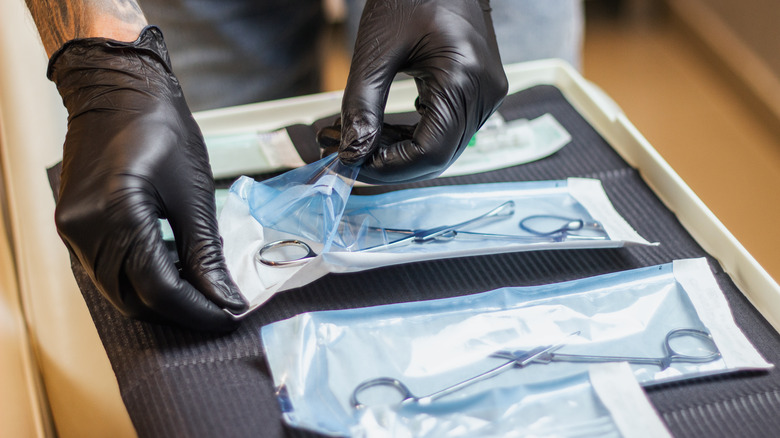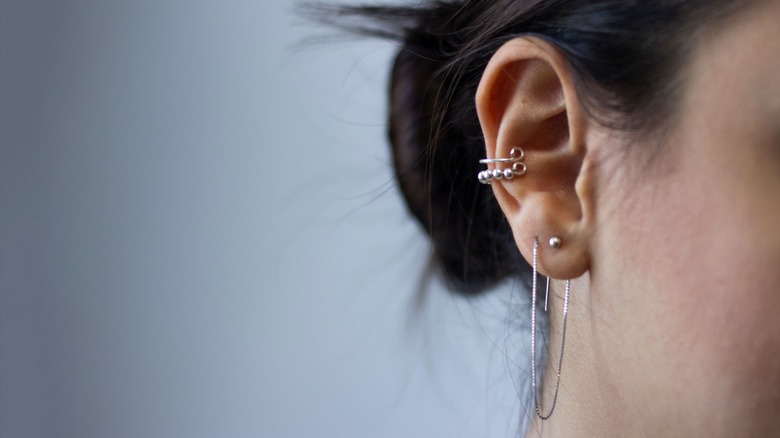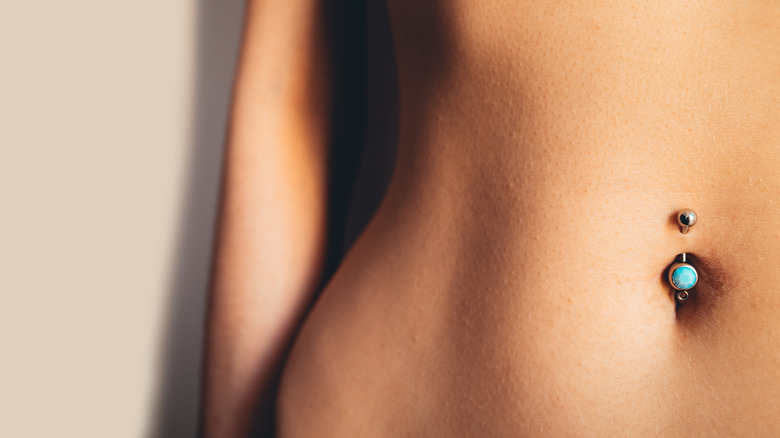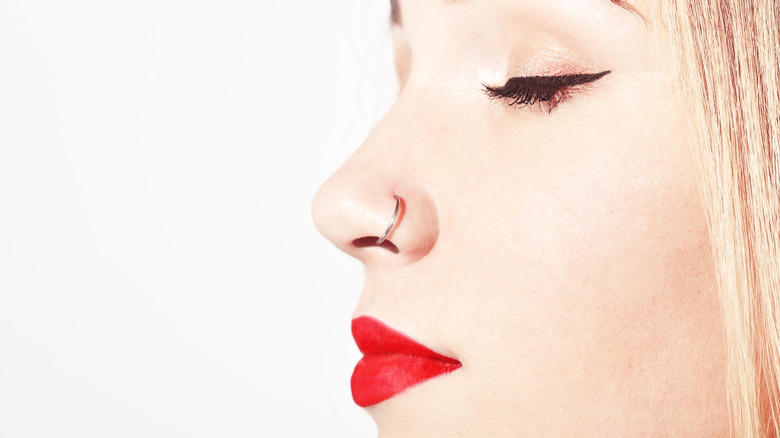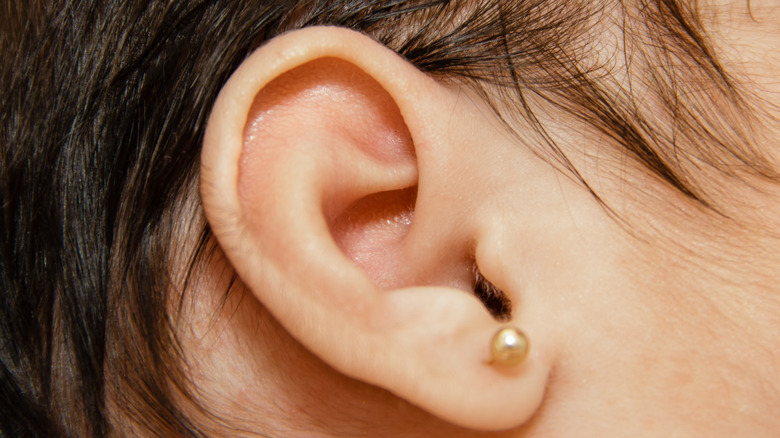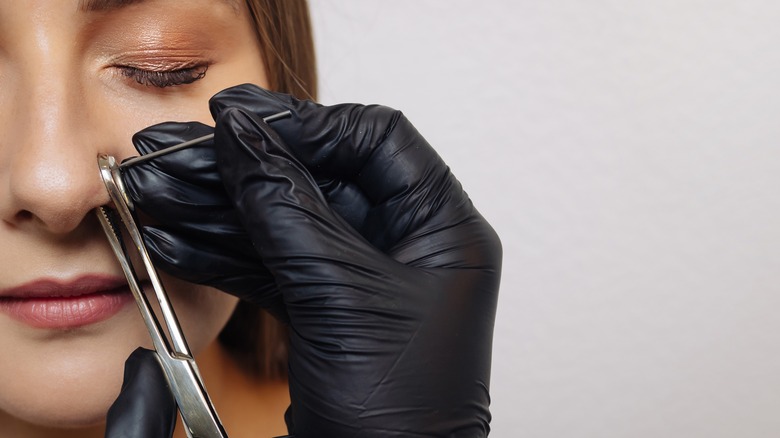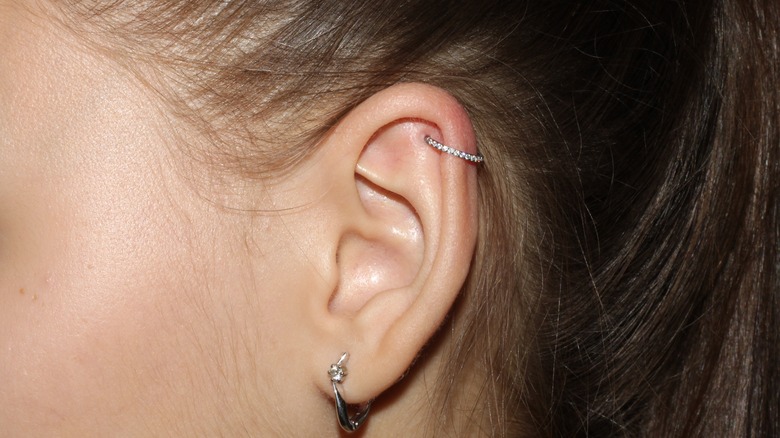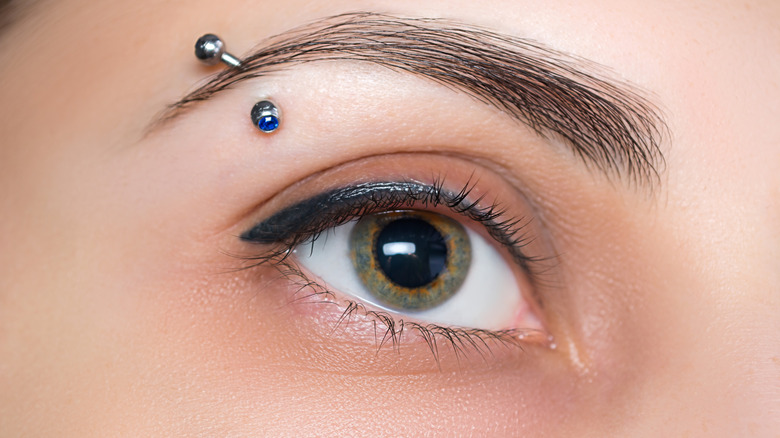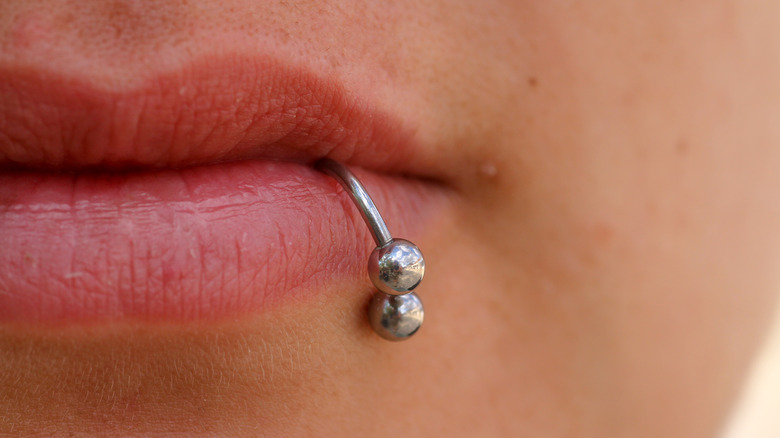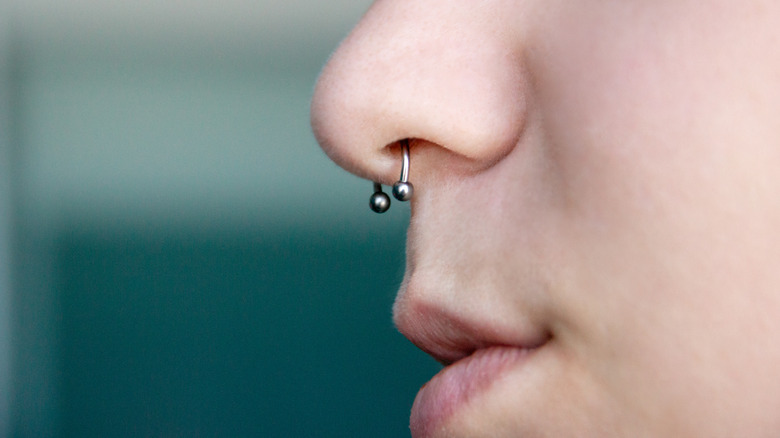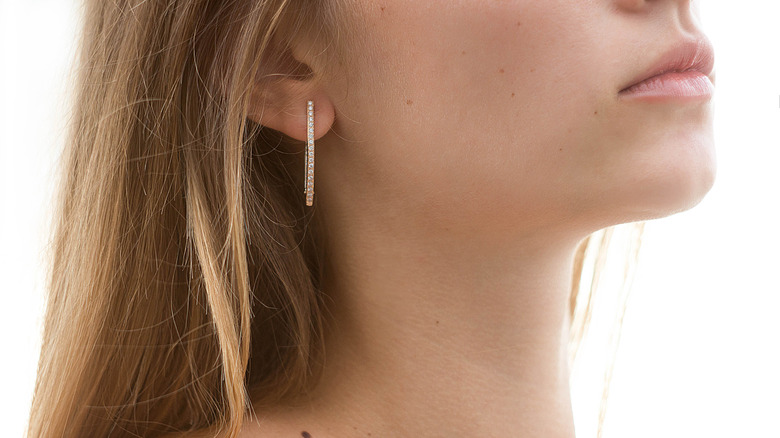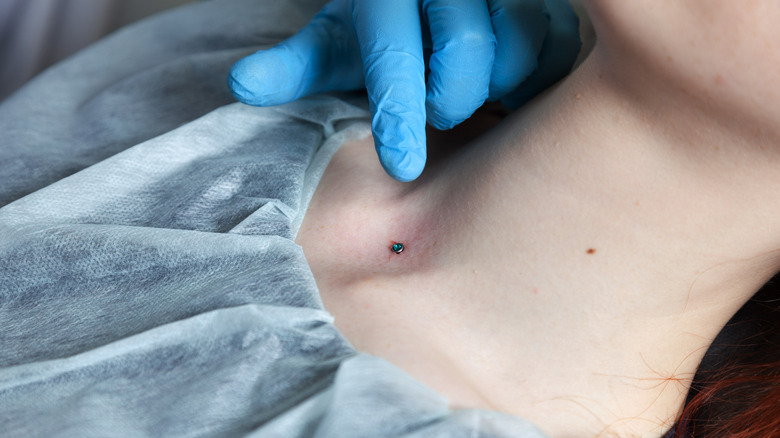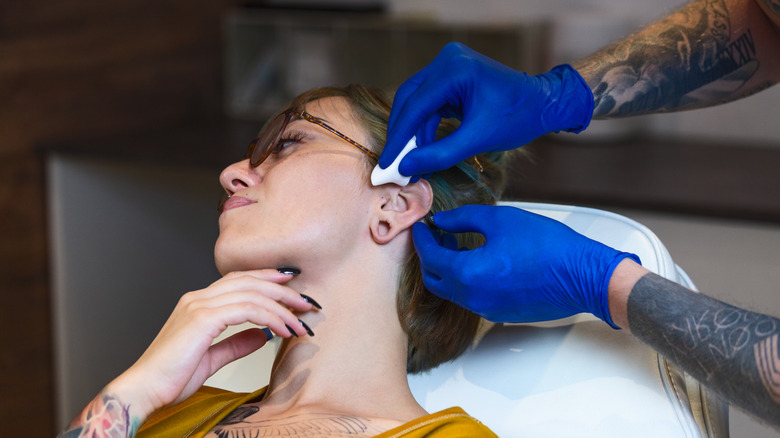When You Get A Piercing, This Is What Happens To Your Body
For thousands of years, humans have used piercings to indicate royalty and wealth, participate in religious rituals, and even ward off demons and evil spirits (via Tribu London). In modern Western society, piercings ranging from dainty gold earrings to bold eyebrow bars are fun and unique ways to self-express. As exciting as they can be, there are things you should know before getting jabbed with a needle — whether it be ear piercings or something more unorthodox. From the healing process to signs of infection to potential allergic reactions, it's important to go into the process informed and prepared.
First and foremost, keep in mind that a piercing is a wound, will cause shock and trauma to your body just as an accidental puncture would, and should be treated accordingly as it heals (via Peace Health). The reaction within your body will be the same physiologically as if you had been cut, burned, or otherwise injured (Anatomy and Physiology via Lumen Learning). Your family doctor and licensed, professional piercers will always be the best source of answers if you are unsure of whether a certain piercing is a wise choice for you, but here's some basic information to get you started on what happens (and what could happen) to your body when you get pierced.
Inflammation will result from the new wound
The inflammatory phase is your piercing's first step in healing, beginning immediately after you're pierced and lasting up to six days (via Rogue Piercing). Right after your piercing occurs, the body will attempt to stop bleeding by forming a clot — this part of the inflammatory phase is called platelet hemostasis, and means platelets have swarmed the wound to prevent germs from entering and blood from escaping. As the scab forms over your wound, you're still likely to see some bleeding, especially if the jewelry is somewhere that's easily jostled, like a navel piercing.
That doesn't mean there isn't plenty of action going on behind the scenes; after hemostasis, some magical proteins called neuropeptides get to work widening your blood vessels and making it easier for infection-fighting immune cells to enter. This stage is called inflammation — while it sounds like a bad thing, inflammation is a critical part of your piercing's healing process, and is a sign that your body is taking steps to protect you from a nasty infection. Neuropeptides also have the important job of triggering mast cells, which are the immune cells that contain beneficial healing chemicals, including enzymes and histamines. The mast cells release these chemicals, signaling to your body that white blood cells need to be sent to the site, says Creation Body Piercing. Then, once white blood cells are at the wound and the open site is stabilized, your body is ready to fight back pathogens and germs that your new piercing may come into contact with. Meanwhile, the healing is about to begin.
Redness and swelling are natural early reactions
When your capillaries and vessels are prompted to open up for more blood, cells, and other fluids, a process called edema — commonly known as swelling — occurs (Anatomy and Physiology via Lumen Learning). This, along with redness, tenderness, or pain are completely normal signs of the inflammatory phase (Creation Body Piercing). The walls of your veins become porous, Anatomy and Physiology explains, to let all the healing chemicals into the tissue.
While the swelling may appear alarming –and may hurt because the pain receptors in the area are put under pressure by the swollen tissues — normal signs of inflammation are not on their own reasons for concern, especially in the early stages of a piercing's healing. Anti-inflammatory over-the-counter painkillers like ibuprofen and aspirin, if these are drugs that you are able to take given your own health and physician's recommendations, can reduce the swelling if the pain becomes too uncomfortable (via Authority Tattoo).
Some discharge is normal
It's easy to panic when a new piercing starts to ... ooze. This is not always a warning sign of a problem, though, explains the National Health Service (NHS). A pale or clear discharge is normal, and made up of dead blood cells, lymph, and blood plasma (via Creation Body Piercing). If the discharge appears thicker and more opaquely white, it may also be sebum, which is oil produced by sebaceous glands and not a sign of infection.
You may not see the actual discharge and instead notice a crustiness around the jewelry when you clean it; this crust, not to be confused with a scab, needs to be removed so that the tissue around your new piercing can continue to heal. This needs to be done carefully and hygienically by spraying the crust with saline three times a day, says Authority Tattoo. This will loosen the dried-up fluid and allow it to fall off on its own, reducing your risk of introducing bacteria and causing an infection. Avoid turning the jewelry around, using cotton balls or swabs, or touching the piercing with your bare hands, Authority advises.
The open wound may let in germs and pathogens
Getting a piercing creates a wound that makes your body vulnerable, and even the most diligent cleaning only reduces — not eliminates — the chance of letting in germs, bacteria, and other pathogens. An infection is possible at any point before your piercing is fully healed, says Creation Body Piercing. Being on alert for the early warning signs of an infection can make treatment easier. While a minor infection in an ear or nose piercing might not seem like a big deal, the Sepsis Alliance explains that an untreated infection in a piercing could lead to sepsis, blood poisoning, or cellulitis. An infection is not always a medical emergency, but these conditions are.
Because a piercing can be placed just about anywhere in the body — from standard earlobes to navels, tongues, nipples, genitals, and even the infamous transmandibular piercing (Axiom Body Piercing) — some piercings may be more vulnerable to infection than others, depending on what they come into contact with. According to healthychildren.org, the navel is likely to become infected not because of its location, but due to its shape, while Peace Health says the earlobes are the most common and safest.
Pus and pain may mean infection
The first signs of an infected piercing — redness, swelling, warm skin, and pain — mimic the normal early reactions to a wound (via the Royal Children's Hospital Melbourne). You may even experience itchiness around the site as the histamines in your body get to work, or you might see small lumps of trapped fluid if you have a cartilage piercing, says the NHS. Because of the similarity in symptoms, you may be unsure if you're dealing with an infection or normal new piercing symptoms.
Pus is the most surefire sign to look for — it can be red and bloody or greenish-yellow, and may have an odor. An infected piercing is also likely to be more swollen and red, hot (rather than warm) to the touch, and more painful than it was the couple of days prior. If the infection increases in severity, you may also develop a fever, shivers, or a general feeling of malaise. To prevent cellulitis, never remove the jewelry from an infected piercing. The opening will likely swell shut, preventing drainage of pus and debris, explains Family Doctor.
Your new jewelry obstructs bleeding and a scab may form
Naturally, a puncture wound and damaged tissue is more than likely to bleed. However, inserting a piece of jewelry will obstruct some if not all of the bleeding; had a piercer stabbed a hole in your body and not immediately placed a piece of jewelry, you'd see a surprising amount of blood, New Flower Studio says. The jewelry post acts as a plug in the puncture wound.
Even with a small amount of bleeding, your piercing is likely to form a scab as the neuropeptides flood the surrounding tissue to start the healing process. At this point, you may think you're in the clear from infection, but don't be fooled; scabs aren't foolproof (via Medical News Today), especially if they become cracked or loose, which may happen when they're jostled by jewelry. As with any wound, it's very important to keep your fingers off the scab and never pick at it.
Certain metals may cause allergic reactions
There is a chance that certain metals in body jewelry may cause an allergic reaction as your piercing heals. The best materials to ask your piercer to use are 14-karat gold, titanium, or surgical-grade steel, according to WebMD. The most common culprits for jewelry reactions are nickel and cobalt alloys, DermNet says, which are more common in gold- or silver-plated and/or lower-end jewelry. While the opportunity to choose more affordable jewelry when getting a piercing is tempting, using quality, hypoallergenic materials is very important, so always choose those options when possible. WebMD explains that you may be having an allergic reaction to a new piercing if there are dry patches and rashes surrounding the area, in addition to itching, redness, and swelling .
If you have an allergic reaction to a new piercing, you're likely to start showing symptoms immediately (via Infinite Body Piercing); and reactions to a cleaning solution are possible too. If you suspect you're allergic to your jewelry, stop in to see the piercer ASAP. According to the Nickel Institute, nickel allergies can't cause anaphylaxis (the type of allergic reaction that would send you to the emergency room), but if you suspect your reaction is emergent, see a doctor immediately.
New skin cells will begin to form
A couple weeks after you are pierced, your body will begin the process of forming new skin (via New Flower Studio). Any scabs that formed may be close to fully healed, but underneath them, new cells called fibroblasts are gathering to start producing collagen — a protein essential for your body's bones, cartilage, skin, and tissues — in a step known as granulation, which is part of the proliferative phase of wound healing (via Shield Health Care).
According to New Flower Studio, oxygen is drawn into the forming tissue that will soon become skin. The fibroblasts cause your piercing wound to contract — essentially "grabbing" onto the edges of the puncture and pulling it together, like letting a stretched rubber band relax. This phase is one of the most important in healing any wound, as it sets the area up for healthy, strong, new skin. The body can (slightly) lower its defenses and focus on healing now that the shock of the puncture is worn off.
New skin re-strengthens over time
It's at least three weeks after you were pierced. By now, any scabbing around the piercing has likely fallen off, and redness, pain, or swelling is minimal. You may not be able to see it, but the skin in and around your piercing is brand new now that the epithelial cells have covered the wounded area during the proliferation stage (via Shield Health Care). This skin is likely to be taut, sensitive, shiny, or pinkish-red. While this is a sign that your piercing has made good progress, it's not indicative of a fully healed piercing and definitely not a sign that you can start changing out your jewelry.
Your skin will need time — a couple weeks up to two years for some wounds, Shield Health Care says — to grow stronger and more flexible as the collagens rebuild and mature. Keep in mind that infections, prematurely removing jewelry, or other trauma to the area will halt or reverse this process (via Byrdie); the wound healing progression is linear, but can circle around and start over.
An overgrowth of scar tissue may occur
An unsightly overgrowth of scar tissue is the last thing you want on a cute new nose piercing, but that is an unfortunate possibility. This scarring is hypergranulation, or hypertrophic scarring, where the fibroblast and collagen have overproduced, leading to a protrusion of tissues and blood capillaries (via Sanara MedTech). These scars are not to be confused with keloids, which are usually more raised, are darker in color, and can spread beyond the wound area.
When it comes to piercings specifically, this is likely caused by too much disturbance as the site is trying to heal: being tugged on, bumped, rubbed against clothing, or caught on something. Poking, twisting, turning, or playing with your jewelry can also lead to hypergranulation, according to Creation Body Piercing, and it's most likely to happen in cartilage piercings, such as the nose and parts of the ear. If you suspect your piercing has developed hypertrophic scarring, don't despair yet; this overgrowth of tissue can be treated by a dermatologist through the following methods, according to the Cleveland Clinic: corticosteroid injections, laser therapy, bleomycin or 5-FU injections, cryotherapy, or surgery.
While annoying and maybe embarrassing, hypertrophic scars are not a harmful condition, the Cleveland Clinic says. Keep in mind that a physician may not want to treat hypergranulation until it's been left to heal for at least one year, and that you may have to remove your jewelry for treatment.
Skin discoloration is possible
You're about to clean your new piercing and notice something alarming: The skin around the site has turned black, blue, gray, or green. This can often be blamed on the metals in your jewelry; according to TatRing, discolored skin is indicative of low-quality jewelry. The alloys in these pieces tarnish when rubbed against your sweat or skin's natural oils, which causes the skin around the area to oxidize and turn a black, blue, gray, or green-ish hue in a process called argyria. A word of advice from piercers: Do not remove your jewelry in a panic if you discover discoloration, as the oxidized skin could quickly get sealed over by the healing wound, and you'll be stuck with a colored patch forever. Your piercer may be able to help you replace the jewelry to a piece that won't stain.
In new piercings, this discoloration could also just be bruising, which is not unusual in freshly pierced wounds. On the contrary, if your skin appears to be getting lighter, thinner, or more transparent, this could be a sign that your body is rejecting the piercing. When in doubt, continue to clean your wound as normal and see your piercer about the discoloration.
The jewelry may migrate
Rejections happen in more than just job interviews and first dates — your body can reject a piercing, too, and migration of jewelry is one of the telltale signs, explains Pierced. Your piercing may be migrating if you notice stretch marks surrounding it, if the jewelry appears closer to the surface of your skin, or if the hole begins to widen.
In addition to migration, you'll know your body is rejecting your piercing if you notice thinning or lightening skin, peeling, flaking, callousing, or inflammation that persists after the first couple of days. This is your body attempting to push the foreign body out and, unfortunately, it will be recommended that you remove the piercing in most cases, although some piercers may suggest trying a different jewelry material or different gauge first, Pierced says. Leaving the jewelry in after it's been rejected can lead to pain and scarring.
Rejection is more likely in some piercings than in others. Dermal or surface piercings in areas with flat, taut skin — like the chest or back — are likely to reject. You may be genetically prone to rejected piercings, or may have allergies to a jewelry's metal that cause your body to reject it. Significant and rapid weight changes, pregnancy, and sickness or changes to your immune system can also lead to piercing rejection.
Piercing is fully healed in three months to a year
If you've successfully dodged piercing rejection, metal allergies, and wound infections, your piercing will at long last begin to heal. However, this timeline is unpredictable based on multiple factors, namely the location of your piercing. SkinKandy says that any cartilage piercings, like in the nose and ear helix, will need between six and 12 months to heal fully — taking longer because there is no direct blood supply to the area — while earlobes are quite speedy at just three to six months. Navels and nipples take the longest, needing at least a year to be completely healed. Despite their daunting location, tongue piercings are quick to heal, with Authority Tattoo reporting that scar tissue will be done developing around eight weeks after piercing.
So what does the all-clear on a fully healed piercing look like? Axiom Body Piercing says that redness and pain going away is a good sign, but not the sign. Your piercing is likely fully healed if there has been no discharge for at least a couple of weeks, the skin around the edges of the hole has smoothed out and pulled inward, and the jewelry can move freely through the hole without pain. Of course, if you're in doubt, talk to the expert that stuck the needle in you in the first place before you start taking jewelry out.

